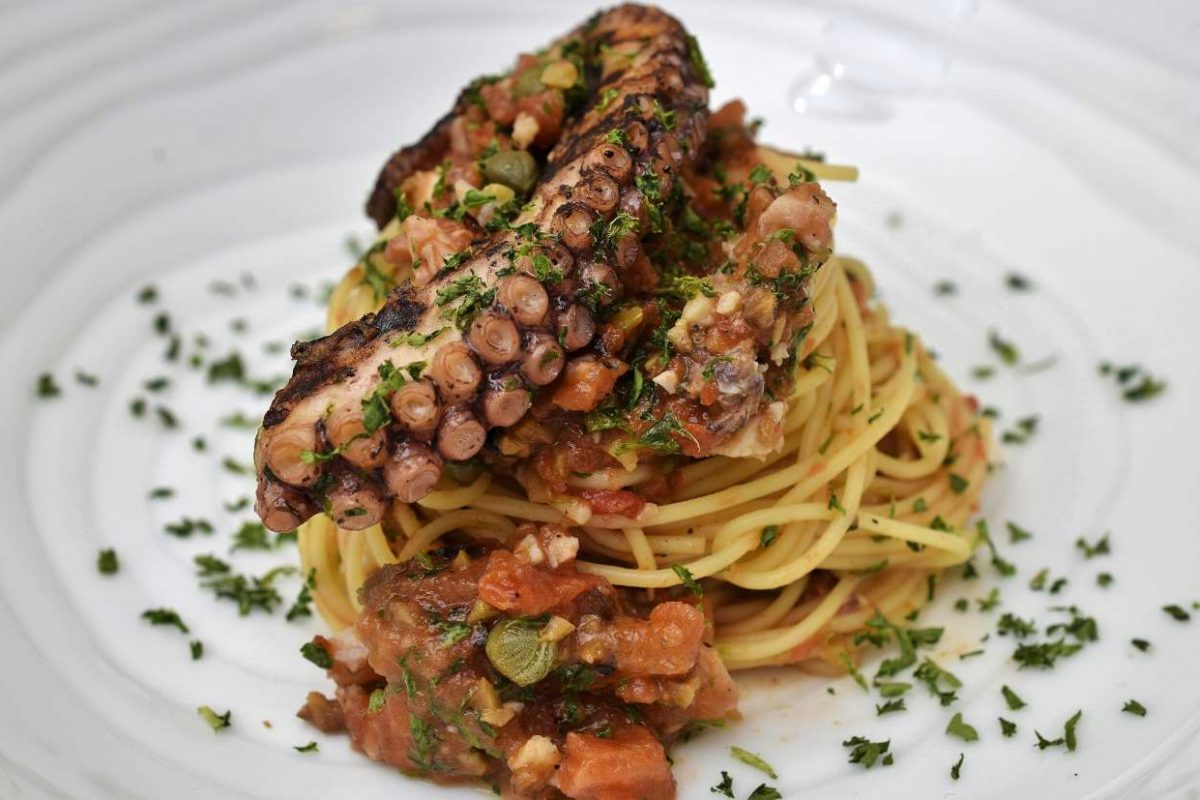Serves 4
Level of difficulty 3.0
Procedure:
Octopus is usually sold from the frozen state. If so, defrost overnight in a refrigerator at 40 F/4 C. The octopus can also be defrosted submerged in 70 F/21 C tap water that is running slowly. Never defrost frozen proteins on a counter at room temperature–this can be very dangerous.
Preheat the sous vide bath to
160 F/65 C
Stage the octopus into a Ziploc 1 gallon freezer bag. Do not seal. Submerge the package and drape the opening of the bag over the edge of the container. Secure the bag with the lid of the container. Make sure that your vessel is full enough so that the water comes in contact with the lid–this seal assures that the octopus stays fully immersed.
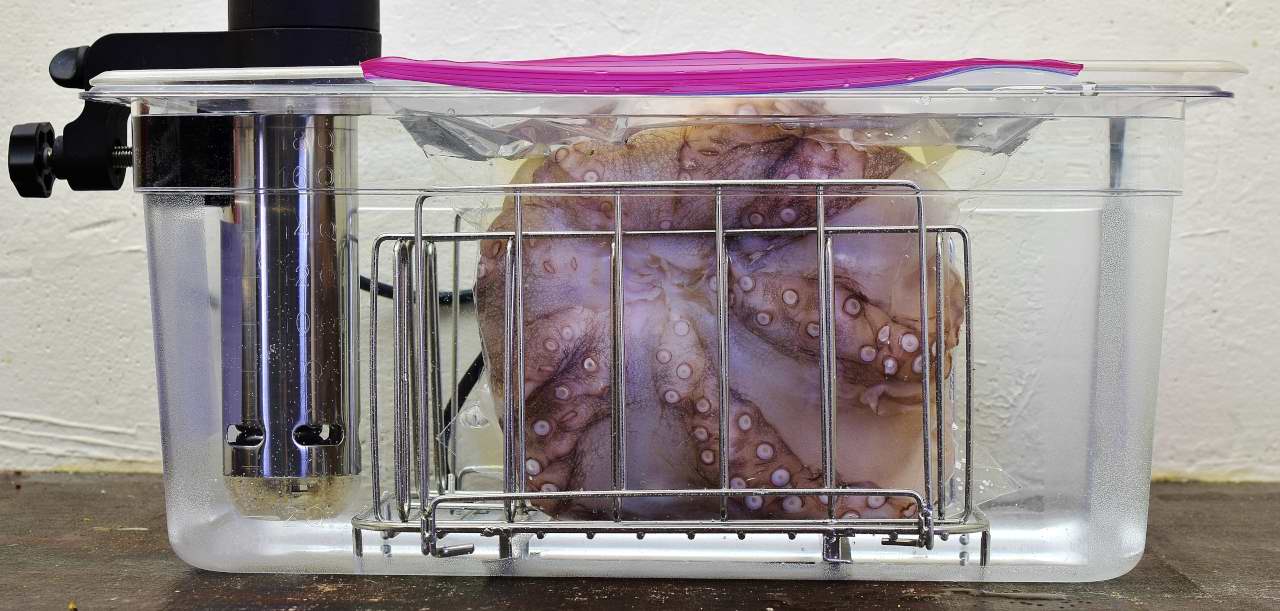
Process the octopus for 2 hours. This will remove the excess water from the octopus. There will be a significant reduction in weight–usually about 85%.
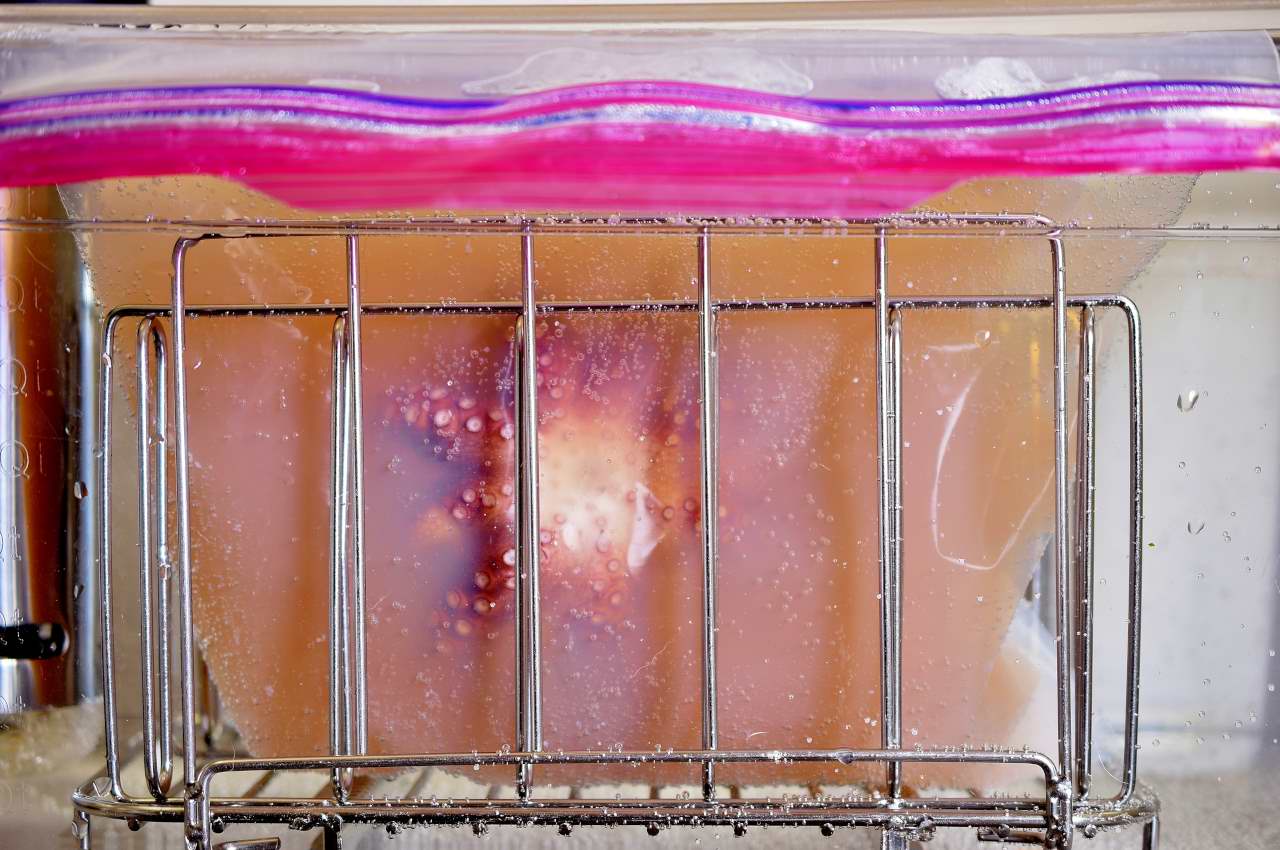 Remove the bag from the bath, drain and discard the water.
Remove the bag from the bath, drain and discard the water.
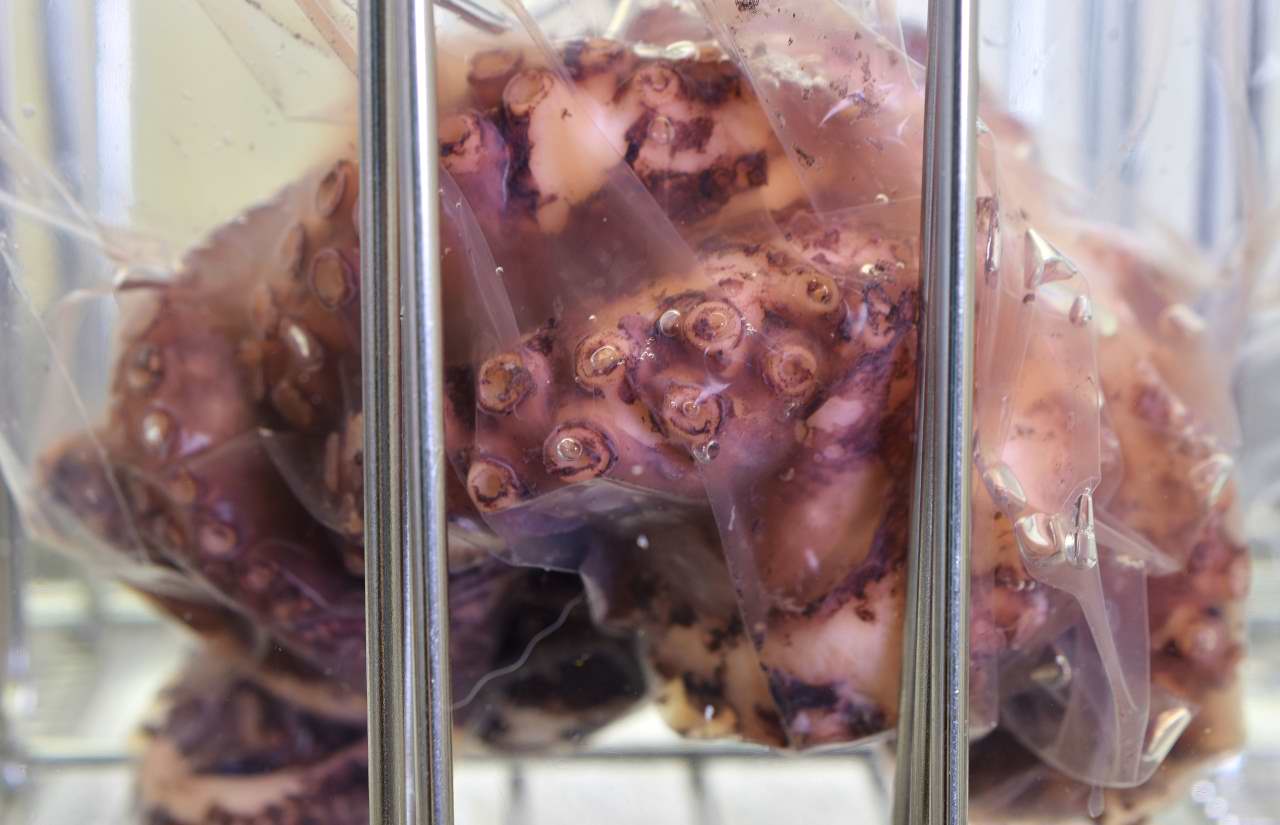 Return the package to the bath and drape the opening over the edge of the container as before. Continue processing for 2 more hours OR UNTIL THE OCTOPUS IS TENDER. This is subjective and may vary from one sample to another. Visit HERE to learn how to measure tenderness.
Return the package to the bath and drape the opening over the edge of the container as before. Continue processing for 2 more hours OR UNTIL THE OCTOPUS IS TENDER. This is subjective and may vary from one sample to another. Visit HERE to learn how to measure tenderness.
After processing, shock the bag in iced water until it achieves 70 F/21 C. Refrigerate at 40 F/4 C until use.
Chopping parsley
Remove the large stems from the bunch of parsley. Dry well with a paper towel–if the parsley is very wet, wrap it in a towel, put it in a plastic bag and vacuum it. It is important that the parsley be dry so that you get chopped parsley and not parsley paste.
Make sure the food processor itself is completely dry and add the parsley. PULSE repeatedly until the parsley is chopped very finely. Remove the blade from the food processor and set aside on a plate. Shake the parsley out on to a paper towel. DO NOT WASH THE FOOD PROCESSOR. Proceed to the next step:
Tapenade:
In a colander, drain the black olives, the green olives and the capers and pat dry with a paper towel. Stage the olives into the food processor along with the anchovies. Pulse until the ingredients are finely chopped.
Remove the blade from the processor and set aside. Remove the chopped ingredients to a small bowl. Add the capers, the garlic powder, and 3 tablespoons of the chopped parsley to the bowl. Toss lightly with the extra virgin olive oil. Grind the black pepper into the relish and set aside. Do not wash the food processor yet.
Preparing the cooked octopus:
Remove the chilled octopus from the bag and use a dry towel to rub off excess darkened membrane from the surface. Remove the legs from the body and set aside. Remove the head if it is still attached. Cut the body into two half circles and remove the beak and throat if they are present–they are usually quite small.
Cut each half of the body section in half. Chop by hand or pulse in the food processor until it is about the same size as the capers and olives. Cut the lemon in half and squeeze through a strainer into the food processor with the octopus. Pulse once. Use a rubber spatula to remove ALL the octopus and stage into a small bowl. Do not wash the food processor yet.
Angel Hair Pasta with Sous Vide Octopus Tapenade
Combine the chopped octopus with the relish. Divide in half–one half for this recipe, one half for the bonus recipe. Refrigerate at 40 F/4 C. Put the colander on top of the sauce pot and pour in the tomatoes. Use a fork to squeeze the excess juice out of the tomatoes. Stage the crushed tomatoes into the food processor and pulse twice–it should still be chunky. Set aside. Simmer the tomato juice/paste on medium/low heat until it reduces by half. Reduce the heat to low and add the tomatoes from the food processor and HALF of the octopus relish. Bring just to a simmer and add the butter. Turn off the burner and cover the pan. While you wait for the sauce to heat, you may wash (or dispense with) the food processor.
Toss the octopus legs with a pinch of kosher salt, a pinch of parsley, and a few drops of vegetable oil. Heat the pan broiler or skillet to 400 F/200 C. Grill or sear the legs until hot and slightly browned. Stage onto a paper towel.
Remove the sauce from the pan to a bowl and set aside. Rinse out the pan, fill half way with water and bring to a boil.
Cook the angel hair as per the directions on the packaging, usually about four minutes. Drain, but DO NOT WASH. Return the sauce to the pan, add the pasta and toss lightly.
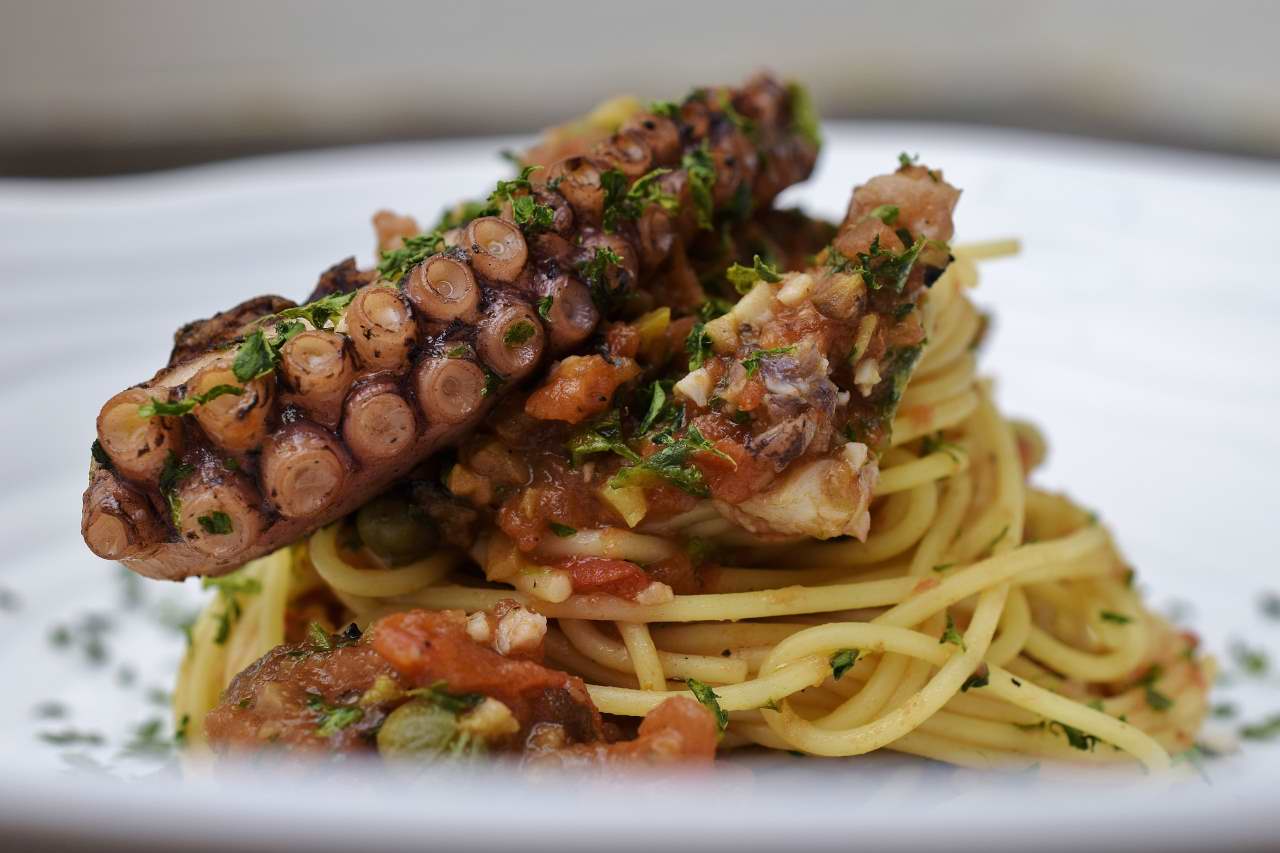
Service:
Divide the sauced pasta among four plates. Insert a fork into the pasta and rotate to form a coil; put a tablespoon under the fork, lift out the coil and place on the plate. Remove the spoon, and then the fork. Add a little sauce to the top of the pasta and a little on the side. Crown each plate with one or two octopus legs. Octopus have eight legs, but they are not all the same size. This is expected. Sprinkle generously with chopped parsley and serve.
Bonus Recipe!
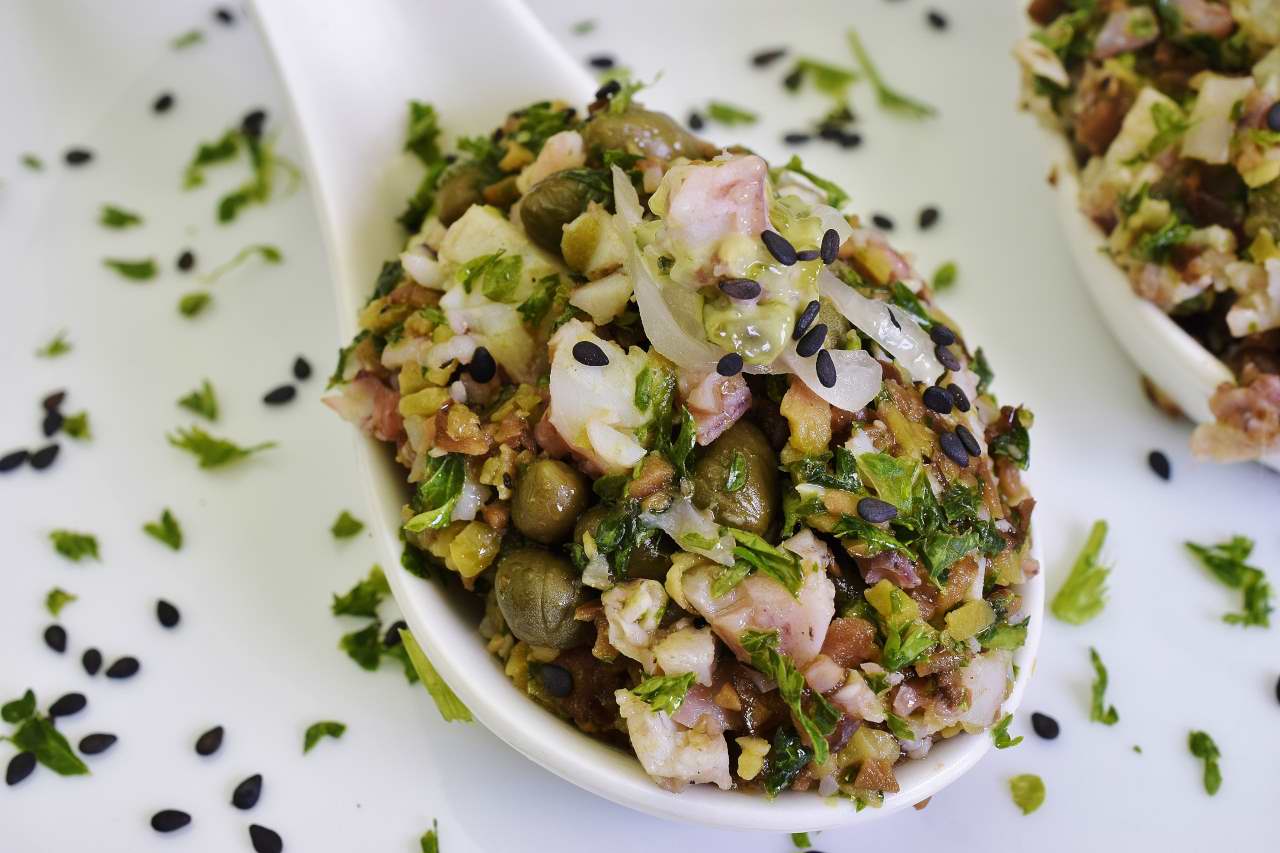
Marinated Octopus Canapés with Tapenade Relish:
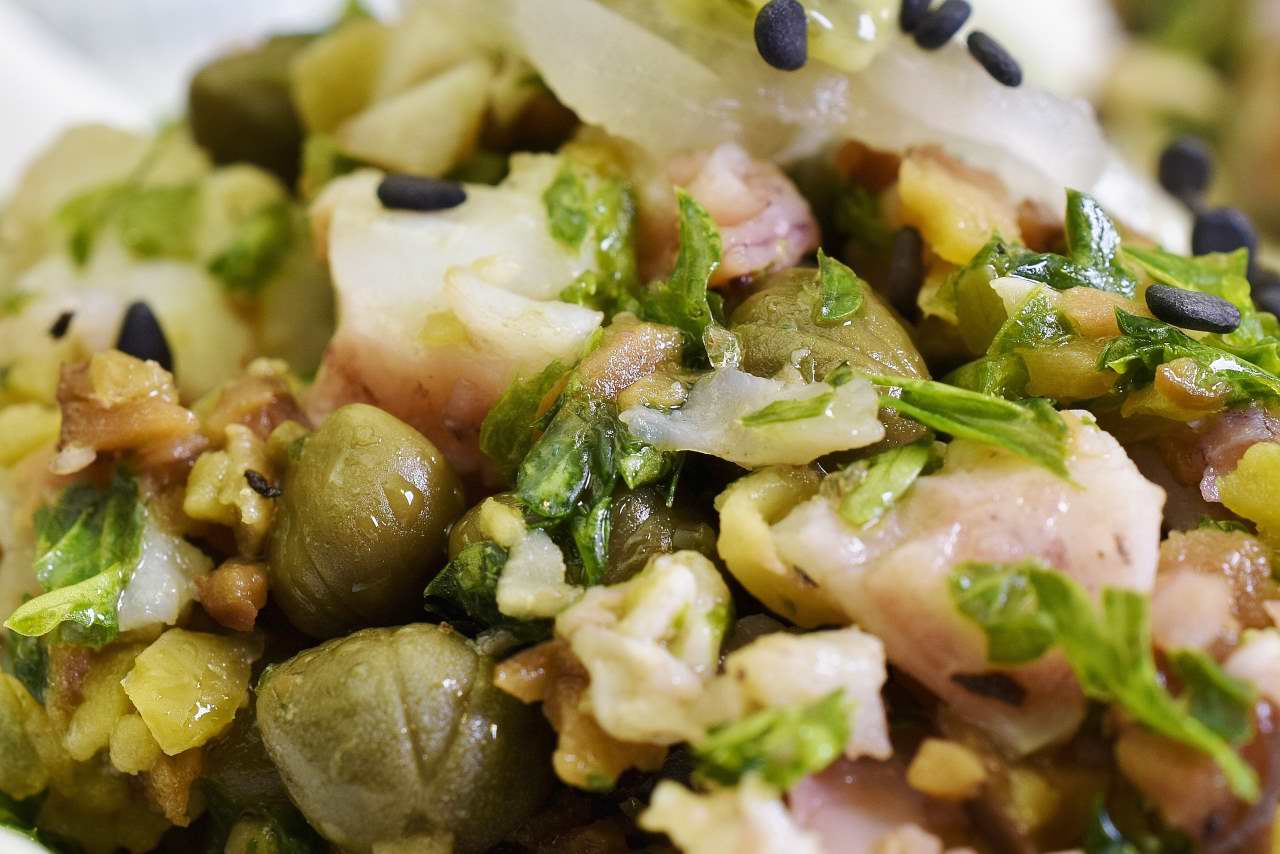
Add the mayonnaise to the remaining octopus relish and stir lightly. Toast the sliced bread, lay on a flat work surface and butter lightly. Top the toast with the octopus relish, all the way to the edges. Use a sharp knife to trim the edges to create uniform squares/rectangles. Reserve (or consume) the excess relish and discard the bread trimmings. Carefully cut each square/rectangle in half and arrange symmetrically on a plate.
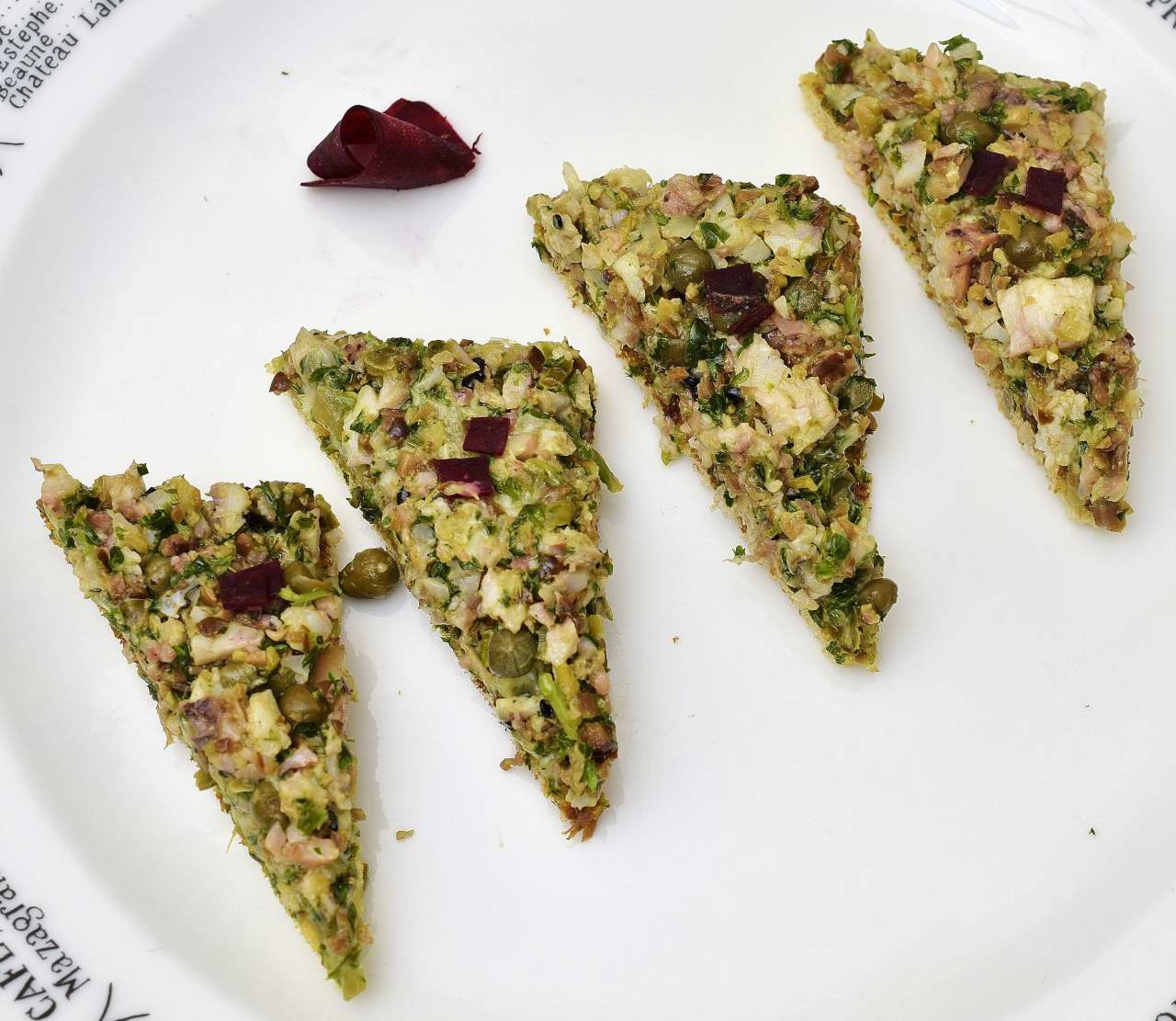
Cut the sliced beet into small squares and use it to garnish the canapés.
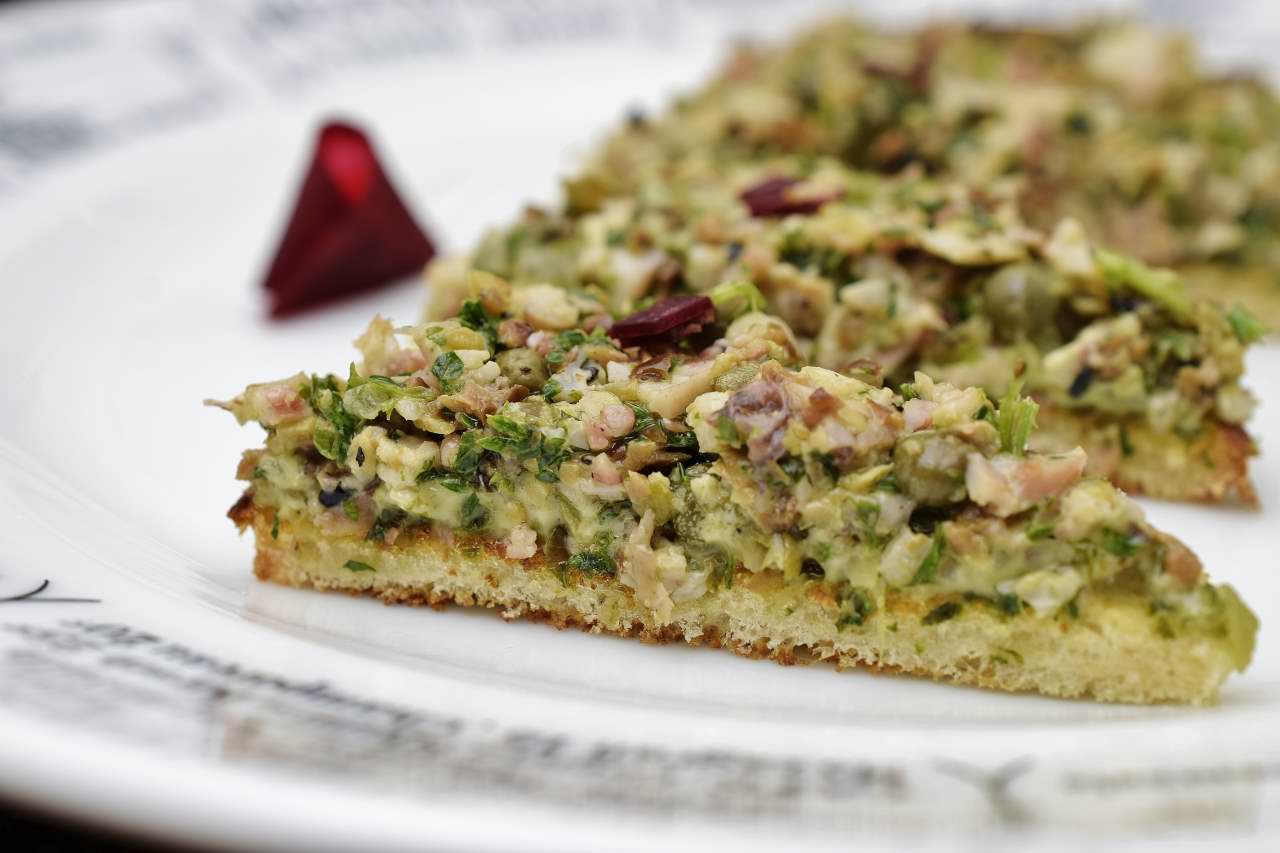
Thanks for visiting!
There are many other ways to serve octopus.

Stay tuned for upcoming articles detailing Octopus Carpaccio…
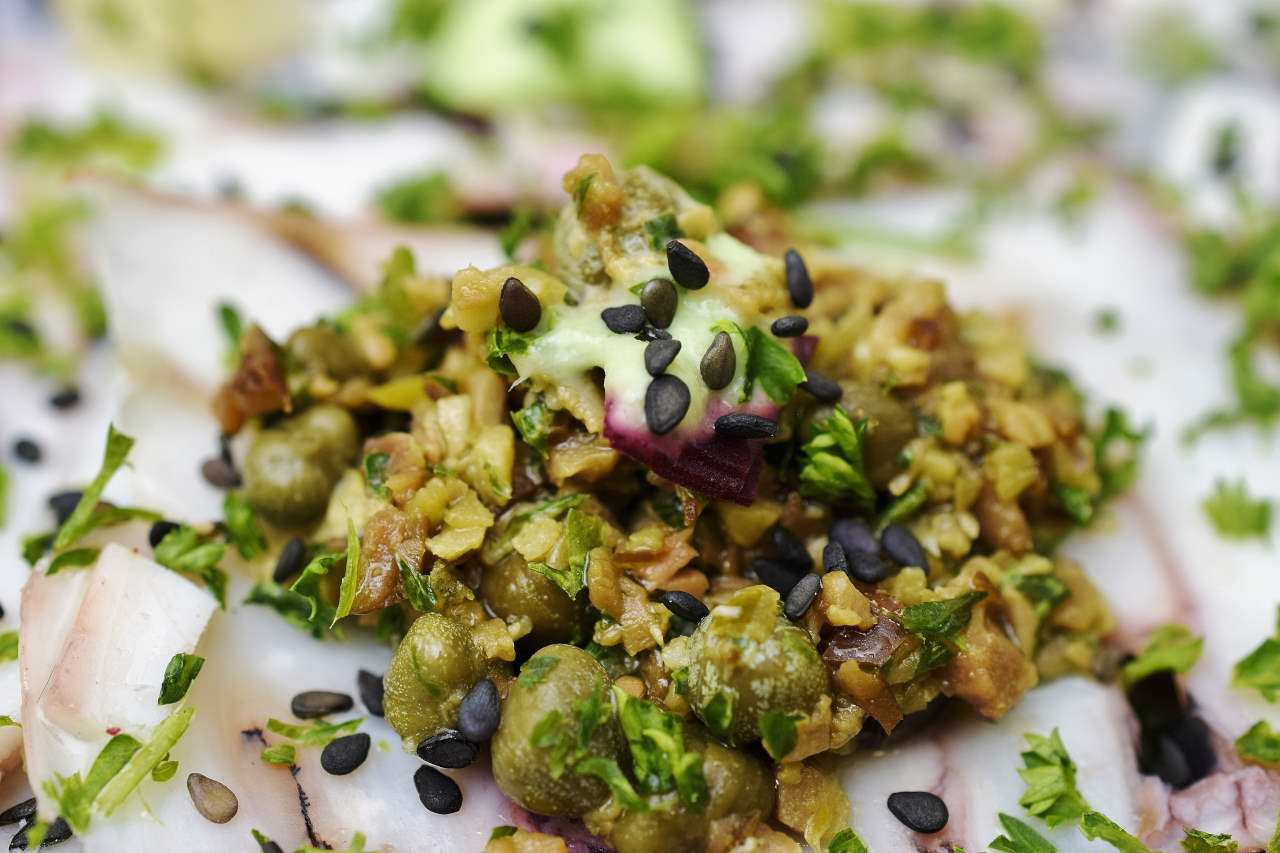
And even crispy fried? Sous vide makes all things possible.
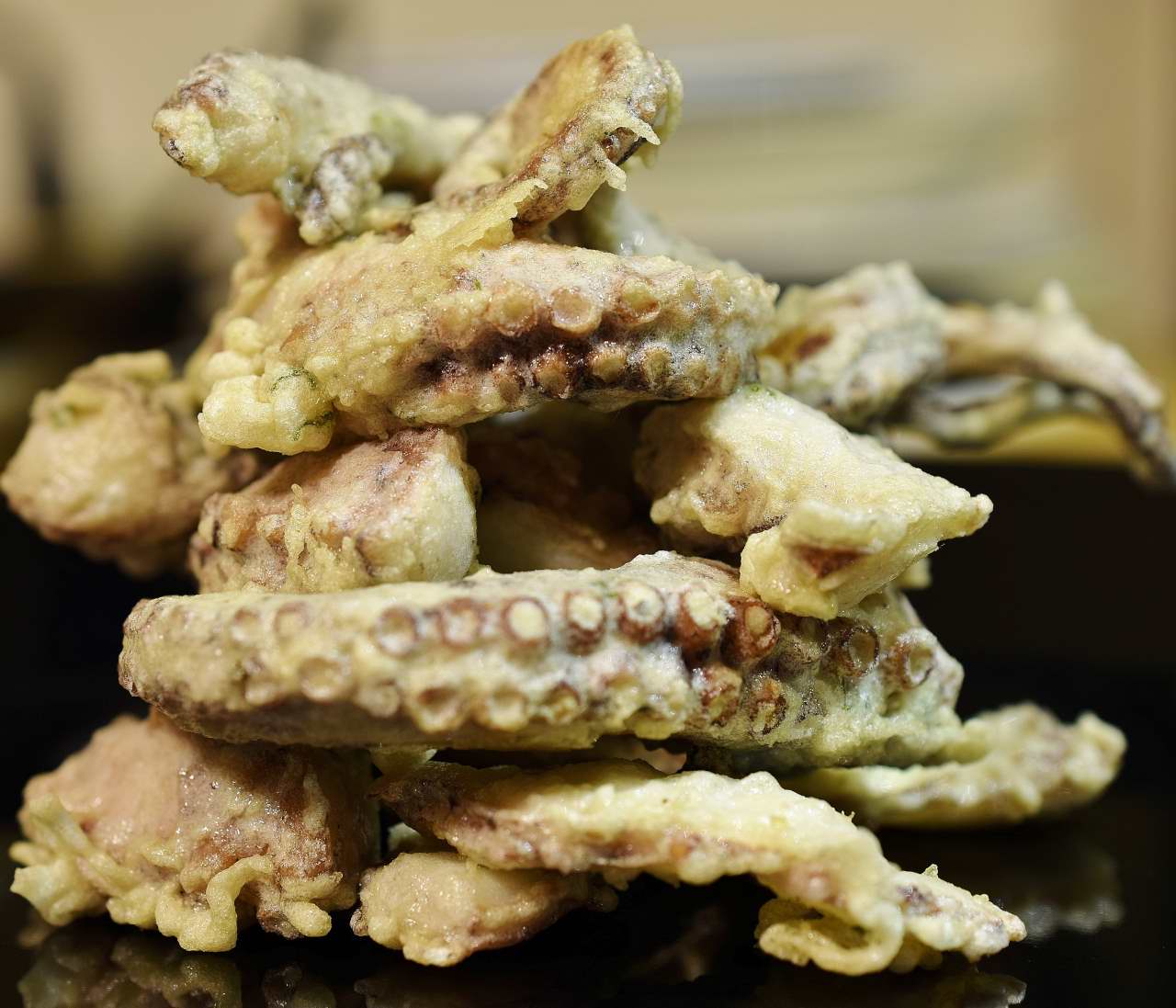
Norm King
